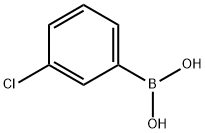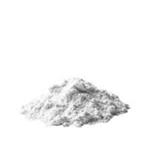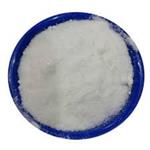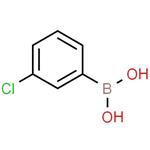Chemical Properties
white to light yellow-green crystalline powder
Uses
Reactant involved in:
- 1,4-conjugate addition reactions with ethenesulfonamides to form arylethanesulfonamides
- Suzuki-Miyaura reactions with dibromotrifluoromethylbenzene
- Cross-coupling reactions with diazoesters or potassium cyanate
- Synthesis of biarylketones and phthalides
- Synthesis of inhibitors including PDE4 inhibitors among others
Uses
3-Chlorophenylboronic acid is employed as a reactant involved in 1,4-conjugate addition reactions with ethenesulfonamides to form arylethanesulfonamides, Suzuki-Miyaura reactions with dibromotrifluoromethylbenzene, cross-coupling reactions with diazoesters3 or potassium cyanate. It is involved in the synthesis of biarylketones and phthalides and synthesis of inhibitors including PDE4 inhibitors6 among others.
Synthesis
Using m-dichlorobenzene as the starting material, iodine particles and 1,2-dibromoethane as the initiator reacts with magnesium in an organic solvent to prepare 3-chlorophenyl magnesium chloride. Then, the trimethyl borate is reacted with an organic solvent to prepare 3-chlorophenyl borate dimethyl ester. Finally, the product 3-chlorophenylboronic acid is obtained through hydrolysis, extraction, and crystallization.
Solubility in organics
3-Chlorophenylboronic acid can be dissolved in organic solvents such as N, N-dimethylformamide, ethyl acetate, and dichloromethane. In addition, it also has specific solubility in low-polarity and non-polar organic solvents, but 3-chlorophenylboronic acid has poor solubility in water.





